
table of contents
- Evergreen, hardy standard trunks from B to F
- Evergreen, hardy standard trunks from G to K
- Evergreen, hardy standard trunks from L to W
- frequently asked Questions
A high trunk in the garden not only looks decorative, it also offers many advantages. The trunks are space-saving and robust. Many evergreen, hardy plants can be raised to a high stem.
In a nutshell
- large selection of hardy stems
- many evergreen high stems grow only slowly
- Regular pruning is essential to maintain the shape
- evergreen doesn't mean that the foliage can't be colorful
- many ornamental plants as high stems are poisonous
Evergreen, hardy standard trunks from B to F
Boxwood (Buxus sempervirens)

- Height: 200 to 450 cm
- Annual growth: 5 to 20 cm
- Flowers: inconspicuous
- Flowering period: March to May
- Fruits: usually does not develop any fruits
- Leaves: leathery, ovate
- Location: sunny to shady
- Soil: normal garden soil
- ongoing pest control (Box tree moth) necessary
- very frost-resistant
Yew tree (Taxus baccata)

- Height: 50 to 150 cm
- Annual growth: 3 to 5 cm
- Flowers: inconspicuous
- Flowering time: March to April
- Fruits: red berries
- Leaves: soft needles, dark green
- Location: sunny to shady
- Soil: well-drained, moist, lime-loving
- very easy to cut
- in all parts poisonous
- suitable for greening shady places
Ice-silver dwarf curly fir (Abies koreana 'Kohouts Icebreaker')

- Height: 40 to 80 cm
- Annual growth: 2 to 5 cm
- Flowers: inconspicuous
- Fruits: red-brown cones, rarely cone formation
- Leaves: silvery needles, evergreen
- Location: sunny to partially shaded
- Soil: well-drained, humic, slightly acidic
- only usable as a dwarf form as a high trunk
Strawberry tree (Arbutus unedo)
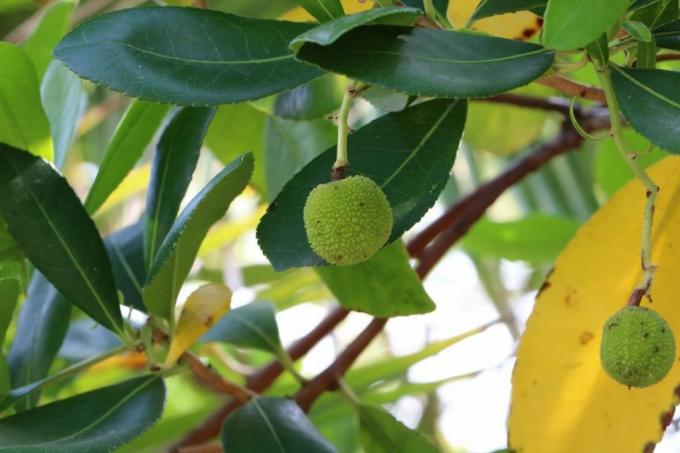
- Height: 100 to 200 cm
- Annual growth: 5 to 20 cm
- Flowers: white, bell-shaped
- Flowering period: October to December
- Fruits: red, warty surface
- Leaves: dark green, shiny
- Location: sunny to partially shaded
- Soil: humic, fresh, low in lime
- only partially hardy
- Fruits are edible
- suitable for bucket culture
Thread cypress (Chamaecyparis pisifera)

- Height: 60 to 100 cm
- Annual growth: 5 to 10cm
- Flowers: inconspicuous
- Fruits: small cones
- Leaves: needle-like to scaly
- Location: sunny to partially shaded
- Soil: well drained, humic
- very hardy
- overhanging growth
- for the Grave planting suitable
Meatberry (Sarcococca confusa)

- Height: 50 to 150 cm
- Annual growth: 5 to 15cm
- Flowers: creamy white
- Flowering period: January to March
- Fruits: reddish elongated berries
- Leaves: evergreen, leathery, elongated, tapering to a point
- Location: partially shaded
- Soil: fresh, humic
- attractive fruit decoration
Evergreen, hardy standard trunks from G to K
Loquat (Photinia fraseri)
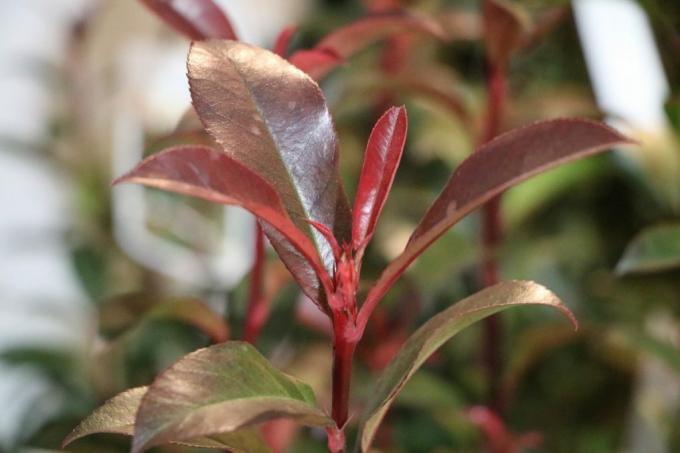
- Height: 100 to 180 cm
- Annual growth: 20 to 40 cm
- Flowers: white
- Flowering period: May to June
- Fruits: red berries
- Leaves: glossy, lanceolate
- Location: sunny to partially shaded
- Soil: fresh, humic, well-drained
- reddish bark
- variegated varieties are also offered
- particularly hardy and easy to care for
Goldliguster (Ligustrum ovalifolium)

- Height: 100 to 170 cm
- Annual growth: 10 to 20 cm
- Flowers: white
- Flowering period: June to July
- Fruits: black
- Leaves: golden yellow, pointed, ovate
- Location: sunny to partially shaded
- Soil: moist, fresh, humic
- rarely blooms as a standard stem
Tip: Not only the gold league can be raised to a high trunk. All privet species can be shaped as tall trunks with a little effort, but are usually associated with a lot of effort when pruning, as they have a strong growth.
Large-leaved holly (Ilex altaclerensis)

- Height: 300 to 500 cm
- Annual growth: 10 to 20 cm
- Flowers: white
- Flowering period: May
- Fruits: red berries
- Leaves: dark green, leathery, prickly, older leaves with few to no spines
- Location: sunny to partially shaded
- Soil: moist, humic, slightly acidic
- only partially hardy and needs protection at low temperatures
- suitable as a container plant
Himalayan cedar 'Feelin' Blue '(Cedrus deodora)

- Height: 40 to 100 cm
- Annual growth: 5 to 10 cm
- Flowers: inconspicuous
- Fruits: reddish-brown cones
- Leaves: soft blue-green needles
- Location: sunny to partially shaded
- Soil: well-drained, nutrient-rich, lime-poor soils preferred
- grows very slowly
- overhanging branches
Japanese spindle bush (Euonymus japonicus)
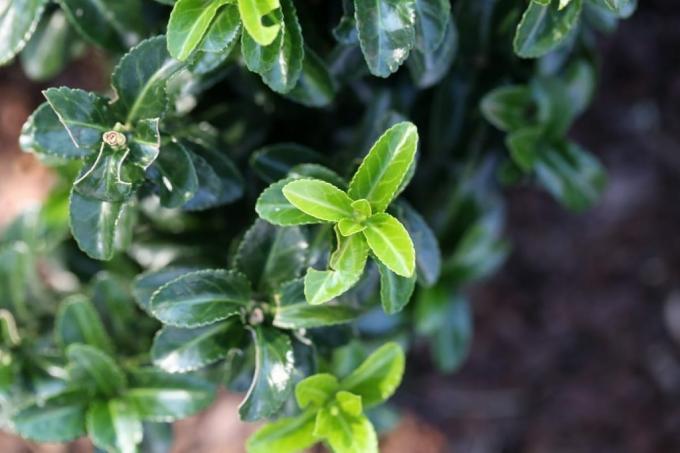
- Height: 80 to 100 cm
- Annual growth: 15 to 20 cm
- Flowers: white-yellow, inconspicuous
- Flowering period: April to August
- Fruits: orange berries, rare fruit decorations
- Leaves: glossy, oval, dark green
- Location: sunny to shady
- Soil: fresh, well-drained
- very easy to cut
- Suitable both as a topiary and as a container plant
- variegated varieties available in white-green or yellow-green
Cherry laurel (Prunus laurocerasus)
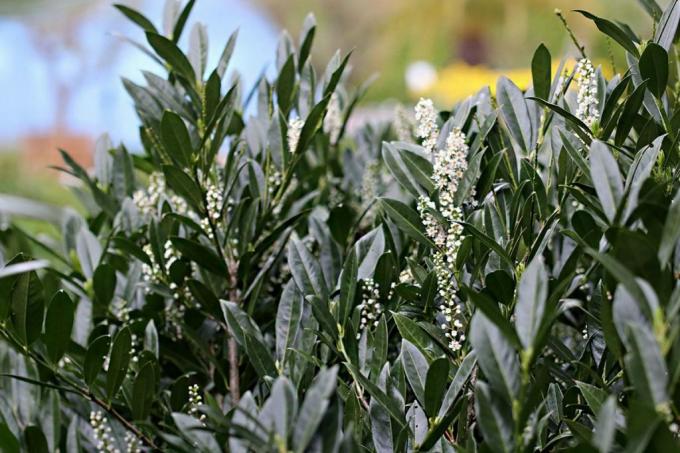
- Height: 120 to 150 cm
- Annual growth: 15 to 40 cm
- Flowers: white, racemose
- Flowering period: April to June
- Fruits: black berries
- Leaves: dark green, elongated
- Location: sunny to shady
- Soil: humic
- Water regularly in full sun
- all parts of the plant poisonous
- Flowers are popular with insects and fruits with birds
Creeping spindle (Euonymus fortunei)
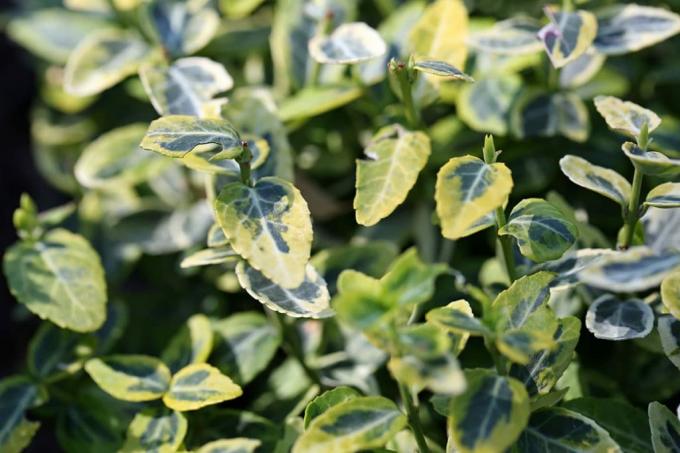
- Height: 40 to 60 cm
- Annual growth: 10 to 25 cm
- Flowers: green-white
- Flowering period: June to July
- Fruits: orange-red berries
- Leaves: ovate, elliptical, evergreen
- Location: sunny to shady
- Soil: fresh, moist, humic
- Varieties with variegated leaves are particularly attractive as standard stems
- Very decorative in the entrance area or as a mini-avenue tree
Evergreen, hardy standard trunks from L to W
Arborvitae (Thuja occidentalis)

- Height: 200 to 400 cm
- Annual growth: 5 to 20 cm
- Flowers: inconspicuous
- Fruits: brownish cones
- Leaves: green
- Location: sunny to partially shaded
- Soil: undemanding
- The “Rheingold” variety with its yellow to orange-red color is particularly attractive
Mediterranean firethorn (Pyracantha coccinea)

- Height: 200-300 cm
- Annual growth: 20 - 50 cm
- Flowers: white, simple
- Flowering period: May to June
- Fruits: reddish fruits
- Leaves: leathery, oval, small
- Location: sunny to partially shaded
- Soil: normal garden soil, well drained
- lush fruit decorations
- Fruits popular with birds
- very intensive cutting
Mussel cypress (Chamaecyparis obtusa)

- Height: 100 to 300 cm
- Annual growth: 5 to 10 cm
- Flowers: inconspicuous
- Fruits: brownish cones
- Leaves: green, scale-shaped, arranged like a fan
- Location: sunny to shady
- Soil: nutrient-rich, fresh, sandy
- very varied due to the growth of the branches
- only needs to be cut moderately
Black pine (Pinus nigra)

- Height: 70 to 120 cm
- Annual growth: 3 to 8 cm
- Flowers: inconspicuous
- Fruits: brown cones
- Leaves: long needles that are grouped into tufts
- Location: sunny
- Soil: dry, fresh, sandy, well drained
- very hardy
- can also be used for decorative arrangements
Note: If you want to plant a black pine in the garden as a high trunk, choose a variety such as "Marie Brégeon" that remains small. Otherwise it can happen that the black pine grows several meters high.
Holly (Ilex aquifolium)
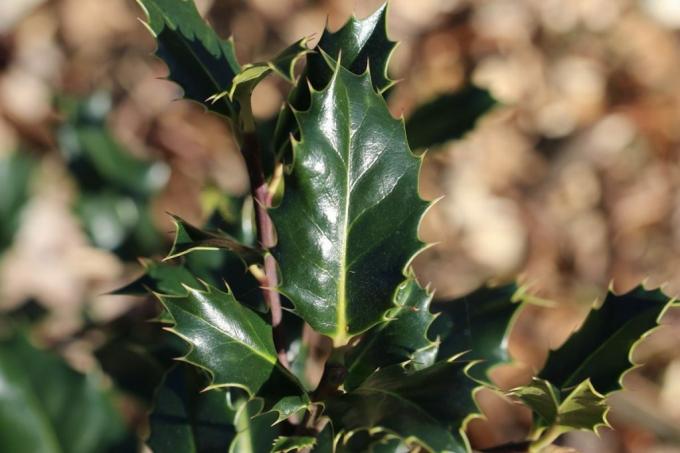
- Height: 150 to 200 cm
- Annual growth: 10 to 20 cm
- Flowers: white, inconspicuous
- Flowering period: May to June
- Fruits: red berries
- Leaves: leathery, intensely green, with thorns
- Location: sunny to partially shaded
- Soil: fresh, well-drained, humic
- In addition to varieties with green leaves, there are also variegated holly trees
Scots pine (Pinus sylvestris)

- Height: 400 to 600 cm
- Annual growth: 10 to 12 cm
- Flowers: inconspicuous
- Fruits: brown cones
- Leaves: long needles, silvery
- Location: sunny
- Soil: dry, fresh, sandy, acidic
Evergreen olive willow (Elaeagnus ebbingei)

- Height: 250 to 300 cm
- Annual growth: 10 to 25 cm
- Flowers: white
- Flowering period: October to November
- Fruits: orange-green, elongated
- Leaves: elliptical, shiny, leathery
- Location: partially shaded
- Soil: normal garden soil, undemanding
- heat resistant
- Flowers with an intense fragrance
Note: The wintergreen olive willow is only evergreen in mild regions. In areas with severe frost, we are hardy, but usually lose their leaves and should also be protected from temperatures that are too low.
frequently asked Questions
With bushes or Regular pruning is essential for trees that are raised to be trunks. It is not only important to consistently shape the crown, but also to remove side shoots on the trunk.
The size of a standard trunk depends on the species. There are high trunks that can reach several meters. But there are also tall trunks, such as the Himalayan cedar, which grows very slowly and takes a very long time to reach its full size.
Yes, a high trunk that is evergreen and hardy can also be cultivated in a tub. However, it is important here that the root ball is protected in winter. The hardy plants do not need any protection above ground, as they survive the frost well.



